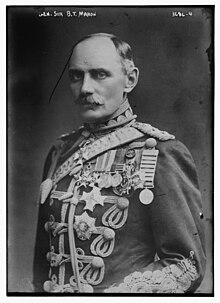
Summary
Sir Bryan Thomas Mahon, KCB, KCMG, DSO, KCVO, PC (Ire) (2 April 1862 – 29 September 1930) was an Irish general of the British Army, a senator of the short-lived Senate of Southern Ireland,[1] and a member for eight years of the Irish Free State Senate until his death.[2]
Bryan Mahon | |
|---|---|
 | |
| Born | 2 April 1862 Galway, Ireland |
| Died | 29 September 1930 (aged 68) Dublin, Ireland |
| Allegiance | |
| Service/ | |
| Years of service | 1883–1921 |
| Rank | |
| Unit | 8th (King's Royal Irish) Hussars |
| Commands held | 2nd (Sialkot) Cavalry Brigade 10th (Irish) Division British Salonika Army Western Frontier Force Commander-in-Chief, Ireland |
| Battles/wars | Mahdist War |
| Awards |
|
| Senator | |
| In office 11 December 1922 – 29 September 1930 | |
| Personal details | |
| Political party | Independent |
| Spouse |
Amelia Milbanke (m. 1920) |
Biography edit
Bryan Thomas Mahon was born at Belleville, County Galway on 2 April 1862.[3] He became a lieutenant in the 8th (King's Royal Irish) Hussars in 1883.
He served in Sudan in the Dongola Expedition in 1896 as Staff officer to Sir Herbert Kitchener, and was present at the Battle of Ferkeh and the operations at Hafir.
In 1899, he took part in the final defeat of the Khalifa as Assistant Adjutant general in charge of Intelligence, and was mentioned in despatches (dated 25 November 1899) by Colonel Wingate with the following words:
I cannot speak in sufficiently strong terms of the excellence of the services performed by this officer. I invariably placed him in general command of all the mounted troops; his personal disregard for danger, intrepid scouting, and careful handling of men, all fit him for high command; his bold and successful seizure of the position in front of Fedil's camp, and his conduct of the fight before I came up, show him to possessed of exceptional qualities as a commander.[4]
In recognition of his service in the Sudan, he received the brevet promotion to colonel on 14 March 1900.[5]
During the Second Boer War Colonel Mahon led a flying column 2,000 strong, consisting mainly of South African volunteers from Kimberley, which came to the Relief of Mafeking. The town, which had been under siege for seven months by Boer forces, was facing starvation. Mahon was appointed a Companion of the Order of the Bath (CB) for his services during the operations,[6] and was invested with the order by King Edward VII on 2 June 1902 after his return to the United Kingdom.[7]
Mahon was appointed a Fellow of the Royal Geographical Society in May 1902,[8] and was briefly Governor of Khartoum in 1903.
During the First World War he commanded the 2nd (Sialkot) Cavalry Brigade[citation needed] and the 10th (Irish) Division during the Gallipoli Campaign. The 10th Division landed at Suvla Bay on the night of 6–7 August 1915. In September he moved with the Division to be head of the British Salonika Army to support Serbia at the onset of the Macedonian campaign. In 1916 General Mahon took up command of the Western Frontier Force in the Egyptian Expeditionary Force.[9]
He was then appointed as the Commander-in-Chief, Ireland, in 1916 in the lead up to the Anglo-Irish War. He retired from the British Army at the end of August 1921.[10]
After his retirement he was elected as a privy council member of the short-lived Senate of Southern Ireland.[1] He was appointed to Seanad Éireann by the President of the Executive Council, W. T. Cosgrave, in 1922 and 1925.[11] His home, Mullaboden in Ballymore-Eustace, County Kildare, was burned down by the IRA in February 1923 during the Irish Civil War. The most valuable furniture had been removed to Dublin after the destruction of Palmerstown, the residence of Lord Mayo, another Kildare member of the Irish Senate, the previous month. A gramophone and typewriter were stolen and one of Mahon's tunics was taken and worn by one of the republicans for a photo taken of the squad that carried out the arson. [12]
He and his wife, Lady Mahon, formerly Lady Amelia Milbanke, widow of Sir John Milbanke, V.C., were not home at the time. In 1923, "malicious injury claims" by the Mahons were filed with Kildare County Council in the amount of more than £60,000; they were awarded £21,341.[12]
Mahon was elected to the Seanad in 1928, and served until his death in 1930.[13]
References edit
- ^ a b "The Senate of Southern Ireland, 1921". www.ark.ac.uk.
- ^ "Members of the Senate of the Irish Free State". www.oireachtas.ie.
- ^ Murphy, David. "Mahon, Sir Bryan Thomas". Dictionary of Irish Biography. Retrieved 30 December 2023.
- ^ "No. 27159". The London Gazette. 30 January 1900. pp. 598–600.
- ^ "No. 27173". The London Gazette. 13 March 1900. p. 1710.
- ^ "No. 27359". The London Gazette. 27 September 1901. p. 6303.
- ^ "The King's Levee and Investiture". The Times. No. 36784. London. 3 June 1902. p. 10.
- ^ "Court Circular". The Times. No. 36767. London. 14 May 1902. p. 12.
- ^ "Sir Archibald Murray's Despatch". 21 November 2007. Archived from the original on 21 November 2007.
- ^ "No. 32441". The London Gazette (Supplement). 30 August 1921. p. 6912.
- ^ "President's nominees for Seanad". Houses of the Oireachtas. 6 December 1922. Retrieved 30 December 2023.
- ^ a b "THE BURNING OF MULLABODEN HOUSE". www.kildare.ie.
- ^ "Bryan Mahon". Oireachtas Members Database. Retrieved 12 October 2015.
External links edit
- Photograph of Mahon
- The Relief of Mafeking by Filson Young at Project Gutenberg, by Filson Young at The Project Gutenberg
- . . Dublin: Alexander Thom and Son Ltd. 1923. p. – via Wikisource.


